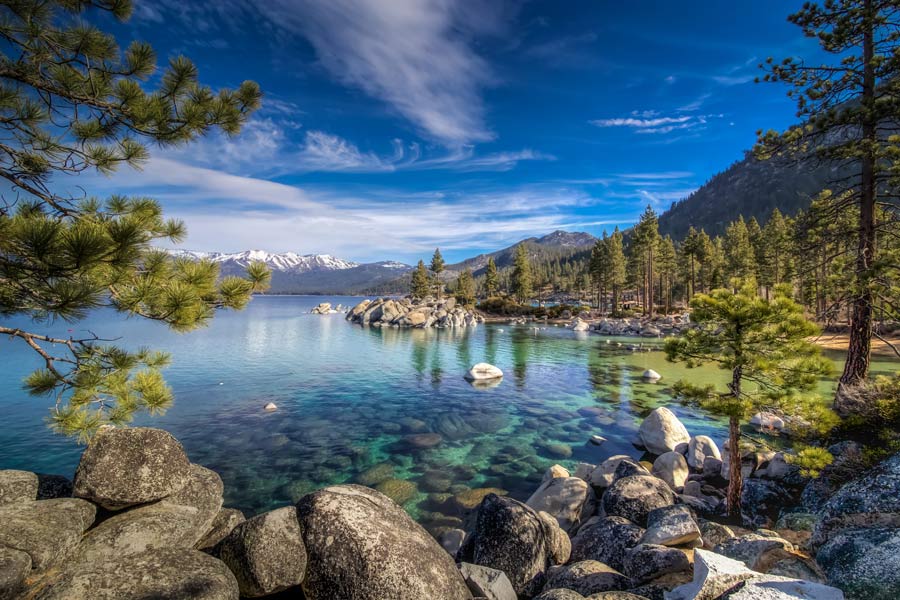South Tahoe based science group is first to climb the largest tree in the world
SEQUOIA NATIONAL PARK, Calif. – Tahoe local Anthony Ambrose has climbed hundreds of giant sequoias in his day, but none like this one.
The General Sherman tree in Sequoia National Park stands 275 feet tall, has a base 36.5 feet in diameter and its largest branch is about as thick as a NBA player is tall, at 6.8 feet. Although there are wider trees as well as taller trees out there, this 2,200 year old specimen contains the most wood by volume than any other tree in the world.

“It’s a magnificent individual,” Ambrose says as he thinks back on the climb that took place Monday and Tuesday, May 20-21. “It was pretty surreal starting up climbing the tree, knowing I was the first person ever to climb it.”
Elation and exhilaration weren’t the only feelings Ambrose encountered on his climb. “You know, it was kind of a sense of exploration and discovery, seeing this massive structure.” One discovery he made was a large hollow fire cave at the top center trunk as well as a dead spire.
The Executive Director, Co-founder and principle research program scientist at the Ancient Forest Society didn’t climb it alone. He had a crew comprised of Program Director Wendy Baxter, and volunteer researchers, Cameron Williams and Rikke Naesborg. The team used arborist rope climbing techniques to scale the tree.
But they weren’t there just for fun and exploration. They were there to give iconic tree a health check.
“We always thought that they were invincible,” Ambrose explains. However, in recent years giant sequoias have caused many land managers to grow increasingly concerned.

“Some limited number of giant sequoia trees appear to have been killed by a combination of fire damage, severe drought, and beetle attack.” He explains the bark beetle is actually native. “It’s always been here, but it hasn’t really been causing a problem for giant sequoias until relatively recently.”
The trees can typically fend off beetle attacks, but Ambrose and other experts believe increasingly severe droughts and fires have weakened the trees enough to move the needle in the beetles favor.
For General Sherman, “The good news is we didn’t really find a whole lot of beetle activity in the crown,” Ambrose says. Although they found some beetles burrowing in branches, “They didn’t seem to be successful. The tree was able to pitch them out and repel them.”
He said there were no noticeable impacts. “It seemed to be thriving and healthy and doing what a giant sequoia normally would be able to do in fighting these beetles off.”
The tree is safe—at least for now. It has endured some close calls though. In 2021, crews wrapped the tree in a protective aluminum material as the KNP Complex fire approached. Prescribed burns in recent decades allowed firefighters to dig a fire line, thwarting the fire’s further spread into the Giant Forest.
Other giant sequoias haven’t been so fortunate.
In 2020 and 2021, Ambrose recalls, losing up to a fifth of mature giant sequoia trees due to severe wildfire. “I’ve been working in these trees for more than 20 years and I’ve never seen any impacts to them up until recently.”
These giants are usually able to tolerate moderate fire; however, the increased severity of recent fire has proven to be too damaging.
“There’s such a limited range, such a small number of them, that we can’t afford to lose a fifth of the whole population in just two years, otherwise, they’re going to be gone in a few decades, I think,” Ambrose says, “so we really need to address this issue.”
Giant sequoias are found only on the western slopes of the Sierra Nevada at middle elevations. Ambrose estimates there are about 75 isolated groves. Most grow in the southern regions of the Sierra, but there is a tiny grove just west of Lake Tahoe in the Tahoe National Forest. That’s the northern most giant sequoia grove, he says.
The hotter droughts becoming for frequent and severe, driving the hotter and more severe fires, making the giants more vulnerable to beetle attacks, all point to a bigger issue. “Really, unless we deal with the global climate change issue,” Ambrose says, “we’re going to continue to increase the pressure on these iconic trees.”
This climb was in collaboration with land managers from sites with giant sequoias. The project overlaps with a multi-year long Cal Fire project the society started through their forest health grants. Over the course of the project, the team will work at multiple sites with giant sequoias to look at tree defenses against beetles. They will test monitoring methods using drones and satellite imagery to develop better beetle detection methods.
The Ancient Forest Society is a non-profit organization and runs off donations, grants, and volunteers. For more information on the society, or how to get involved, you can visit their website, ancientforestsociety.org.

Support Local Journalism

Support Local Journalism
Readers around the Lake Tahoe Basin and beyond make the Tahoe Tribune's work possible. Your financial contribution supports our efforts to deliver quality, locally relevant journalism.
Now more than ever, your support is critical to help us keep our community informed about the evolving coronavirus pandemic and the impact it is having locally. Every contribution, however large or small, will make a difference.
Your donation will help us continue to cover COVID-19 and our other vital local news.














